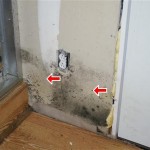Basements and every sleeping room should have at least one emergency escape-and-rescue opening. Such openings should open directly onto a public street, public alley, yard or court.
The emergency escape-and-rescue opening should be operational from the inside without the use of tools, keys, or special knowledge.
Basement egress windows have special requirements. Since you’re below ground, you have to make sure that the window can still fully open without obstruction. Make sure the basement window well has enough area to move around in and if the well is especially deep, make sure you have a ladder attached to it for an easy getaway. Also, if the well is under a deck, make sure there is enough space between the deck and the window. In other words, give yourself enough room to escape. These specialty windows don’t do anybody any good if there are other exterior obstacles that may end up trapping you.
A typical basement walkout is a below-grade entrance to a basement. There should be a set of stairs and a landing at the bottom of the stairs. The walls and steps of a walkout are commonly made of concrete, but can be made of a variety of materials, including wood. A walkout may be covered with a permanent roof structure, or it may be open. The walkout may have a cover that can be opened or removed.
Structurally, for houses, the basement walls typically form the foundation. In warmer climates, some houses do not have basements because they are not necessary (although many still prefer them). In colder climates, the foundation must be below the frost line. Unless constructed in very cold climates, the frost line is not so deep as to justify an entire level below the ground, although it is usually deep enough that a basement is the assumed standard.
 Basement floor drains need to be filled regularly to prevent the trap from drying out and sewer gas from escaping into the basement. The drain trap can be topped up automatically by the condensation from air conditioners or high-efficiency furnaces. A small tube from another downpipe is sometimes used to keep the trap from drying out. In areas where storm and sanitary sewers are combined, and there is the risk of sewage backing up, backflow prevention devices in all basement drains may be mandated by code and definitely are recommended even if not mandated. A blocked floor drain can cause water damage and possibly even mould if not inspected and repaired.
Basement floor drains need to be filled regularly to prevent the trap from drying out and sewer gas from escaping into the basement. The drain trap can be topped up automatically by the condensation from air conditioners or high-efficiency furnaces. A small tube from another downpipe is sometimes used to keep the trap from drying out. In areas where storm and sanitary sewers are combined, and there is the risk of sewage backing up, backflow prevention devices in all basement drains may be mandated by code and definitely are recommended even if not mandated. A blocked floor drain can cause water damage and possibly even mould if not inspected and repaired.
This first unfinished design, found principally in spaces larger than the traditional cellar, is common in residences throughout America and Canada. One usually finds within it a water heater, various pipes running along the ceiling and downwards to the floor, and sometimes a workbench, a freezer or refrigerator, or a washer/dryer set. Boxes of various materials, and objects unneeded in the rest of the house, are also often stored there; in this regard, the unfinished basement takes the place both of the cellar and of the attic. Home workshops are often located in the basement, since sawdust, metal chips, and other mess or noise are less of a nuisance there. The basement can contain all of these objects and still be considered to be “unfinished,” as they are either mostly or entirely functional in purpose.
Finished basements are always suspect for water and moisture problems which can sometimes be hidden from view. The Barrie Home Inspector uses moisture meters and thermal imaging cameras to detect otherwise hidden moisture issues.
